#propane gas storage tank
Explore tagged Tumblr posts
Text
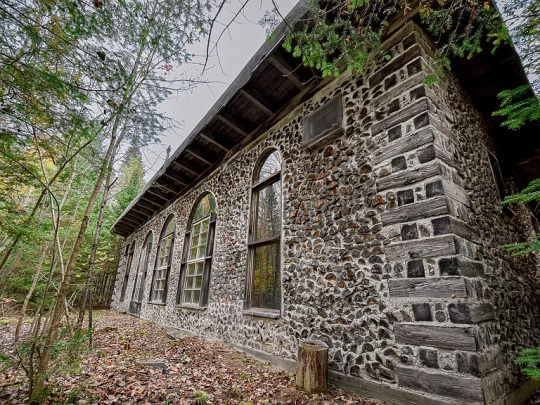

This is a most unusual home. made of slate, stone, and cord wood. I thought it was ancient, but it was only built in 1986. It's in 18 acres of woodlands in Abbot, Maine, has 2 bds. 0 baths, (you'll see what it has), $139,900 and it has a pending sale.
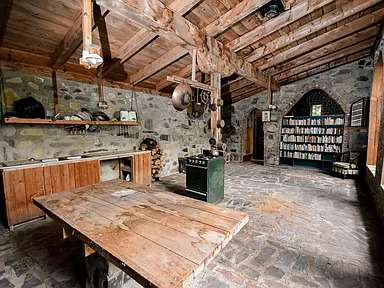
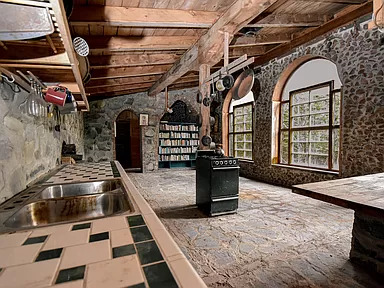
It's rustic as can be. Look at the stone floor- it looks a little rough and would tear a mop to pieces. The windows are nice, the walls, and the shelving, too. This must be a living room/kitchen combo. Don't care for the stove in the middle of the room, though.

Built-in table and shelving.

There's a nice little storage for logs in the wall, but I don't see a fireplace or wood burning stove.
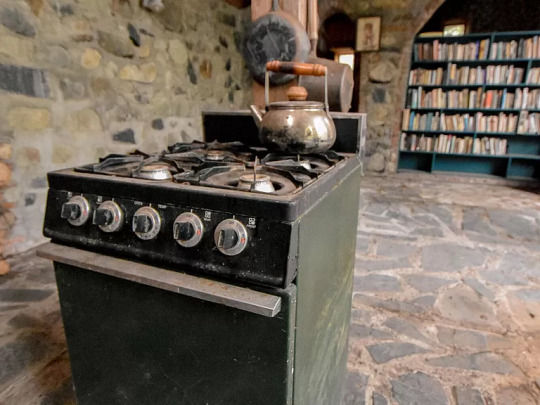
The stove looks charred. Everything needs a good cleaning.
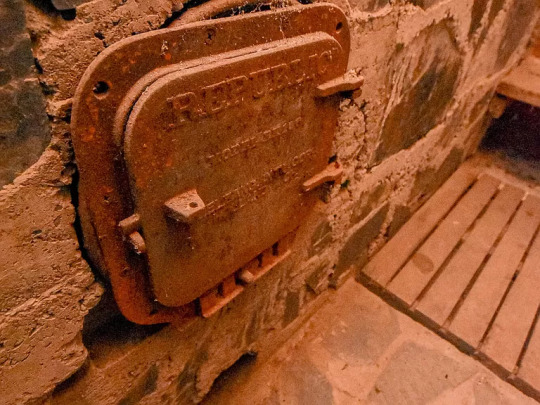
This is a wood burning heater for the hot tub. According to the description, it needs to be restored.
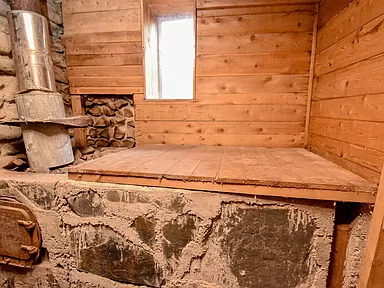
I imagine that the hot tub is covered.
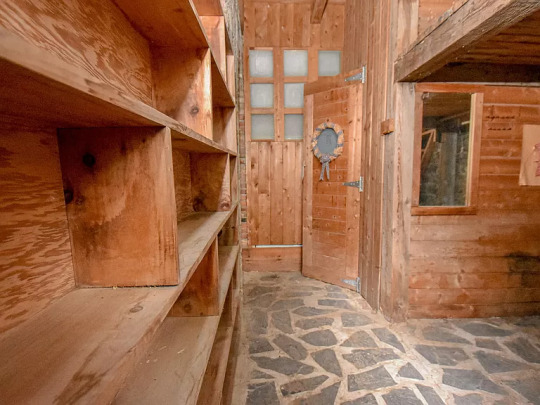
Then, back here is some shelving and the sauna, which will also need restoration.
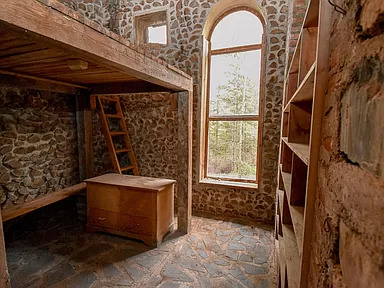
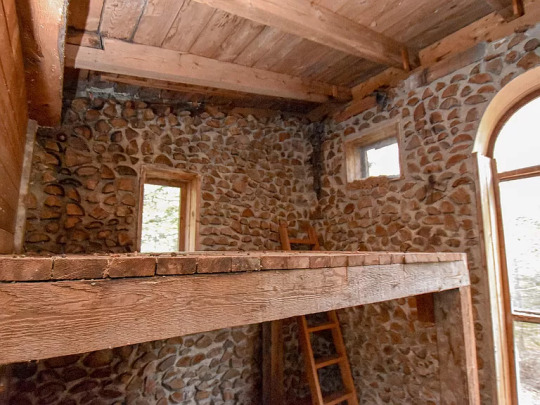
Bedroom #1 has an upper bunk style bed and built-in shelving.

Bedroom #2 also has an upper bunk bed.
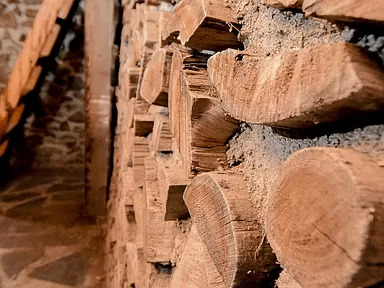
Closeup of the cord wood wall.
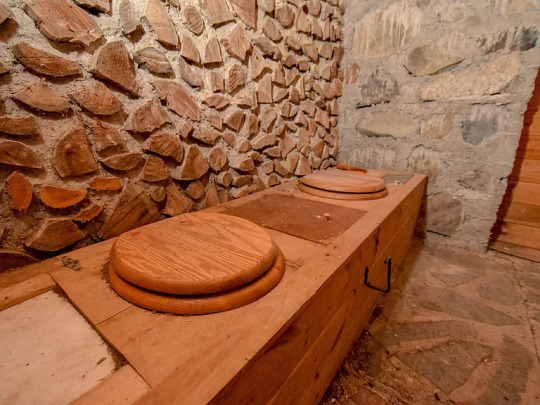
This is your toilet. It's a double.
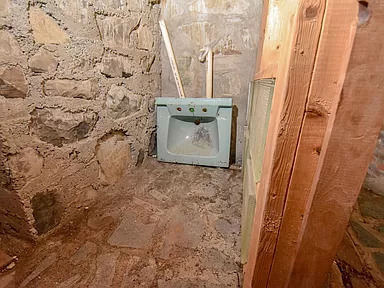
It looks like they intended to put in a sink and plumbing.
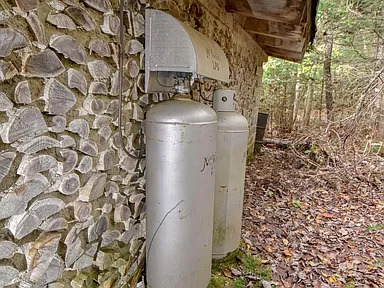
Outside are 2 propane gas tanks.
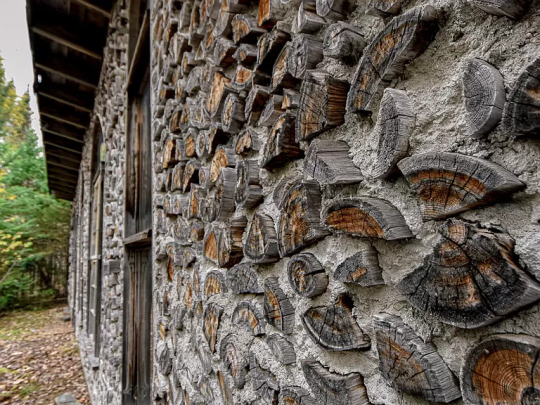
On the exterior the weathered cord wood walls look like stone.
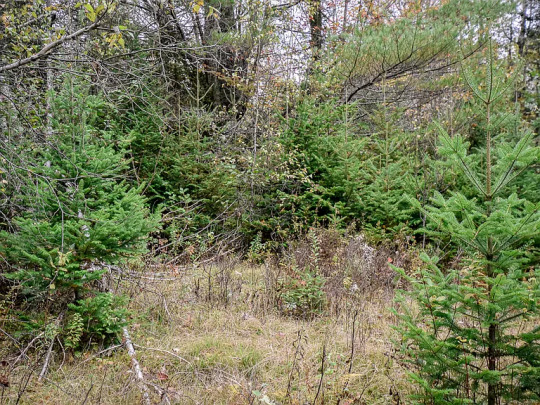


The 18 acres of woodlands are untouched.

Look at the mushrooms on this tree.

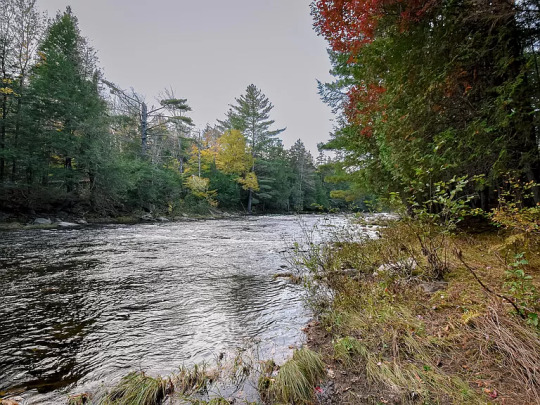
Plus a river runs thru the property.
132 notes
·
View notes
Note
whats the biggest safety hazard you've committed in any lab?
This is a very funny question, and a little bit up to interpretation of the question?
For safety hazards I have personally been harmed by/exposed to, these come to mind:
1) exposure to silica/glass dust at my advanced manufacturing internship (sorry, not technically a lab) where I cut and laid up structures made of layered fiberglass and resins, we had a shop vac set up by the CNC machine drill bit to suck in the dust but yknow. It wasn't perfect. And I also had to clean out the shop vac during the internship. Permanent glass dust in the lungs is a bit spooky.
2) cutting myself on the (used) razor in the cryotome when I was sectioning rat brains for an internship in a translational medicine lab. Pretty gross because of the biological contact but the cut itself was small and tbh lab rat tissues are way cleaner than most food meats so maybe this one wasn't actually that bad.
3) exposure to solvent fumes/powderized toxic chemicals while setting up reactions or doing workups, or OH DEF WHILE MAKING SDS PAGE GELS. But like, one day I was rotovapping like, liters of DCM and methanol which are p carcinogenic. Rotovaps don't normally live in a fume hood, but the air flow in my lab is poor and the air is way too hot so stuff readily vaporizes and every time I swapped out the collection flask some stuff would drip onto the bench and go into the air. Water also kept condensing on the outside of the cold finger, and while I was swapping the flasks, it would freeze on the ball/socket joint and fuck with proper sealing. So during rotovapping some vapors continued to escape. Oh and in the biotech lab at my community college we had ethidium bromide like. fucking everywhere. But that's not actually as bad for you as people make it out to be (otherwise there would be a lot more dead undergrads in the world lol)
There were some scary hazards in theory- like discovering after we moved my current lab that there were a bunch of water reactives/pyrophorics/self reactive chemicals that were previously kept in the inert gas environment of the glove box and for about a month lived on the bench top, maybe parafilmed or in ziplock bags but otherwise fairly exposed, while we organized and sorted all the chemicals into proper storage locations. I've had some glass explode on me under pressure or crack under heat, but usually within a fume hood (and I have goggles on whenever I am in lab). I work with liquid nitrogen fairly often now and scare myself overfilling Dewars and getting it on my gloves.
In a NON lab setting, my dad and ex gf had a blacksmithing shed in the backyard. So, heat hazards, sharps hazards, gas hazards, etc. Some acids for etching damascus that were left out in unlabeled containers. I've burned myself grabbing steel I assumed was cold (because it was black), but was several hundreds of degrees. The WORST thing is we used to have a wooden support table underneath our home built forge. The forge was fairly well insulated but ig it ran too hot for too long one day and at night the table started smoldering. It caught fire, right next to a bunch of propane tanks. We wouldn't have noticed either if my friend sleeping over that night- he left to hookup with someone off of grindr in the parking lot next door, came back, and saw the fire when he came back in the apartment. Woke us up and we put it out lol. Replaced that fucker with a welded steel table after that.
And then my dad is a weapons manufacturer/engineer so I've grown up around tons of guns and explosives and leaded ammunition and blah blah blah. So I guess those were safety hazards too.
5 notes
·
View notes
Text

2024-12-24: Vermont (Hex 24)
The road meanders and weaves over rolling hills covered in forests. Beech, birch, and maple trees cling tightly to the cool ground; the forests conceal a variety of wildlife.
Notable Feature: The Lotus Eater Forest (Resource)
Consisting of several dozen acres of boreal forest on the edge of a lake, the Lotus Eater Forest is named after the lotophages in Homer’s Odyssey. Several of the trees here produce a chemical aura that is mostly imperceptible to humans but makes mammalian Beasts docile and unafraid of people. For every 4 hours a person waits in the forest near one of these trees, an animal native to the area wanders into the influence of the tree. Roll 1d12 and consult the table below to see what animal appears.
Animal Caught By The Trees (1d12)
Coyote (Use Hyena statblock)
Fox, Red or Gray (Use Jackal statblock)
Bobcat (Use Panther statblock)
Ermine, Weasel, or Mink (use Weasel statblock)
Mountain Lion (Use Panther statblock)
Otter (Use Giant Weasel statblock with a swim speed of 40)
Fisher or American Marten (Use Badger statblock)
Skunk (Use Troglodyte statblock with 4 HP and no chameleon skin)
Raccoon (Use Giant Rat statblock)
Black Bear
Deer
Moose/Elk (Use Elk statblock)
Animals found in this way can be easily captured in this stupefied state. Some people in other places would pay good money to have some of these creatures as exotic pets. The animal recovers from the effects of the trees after being out of their influence for 1d4 hours. Sticks and small branches taken from these trees can be placed near creatures to prolong the effects (useful for transporting creatures!), but will lose their potency after 12 hours.
Service Station: Unity Heating Distributors
A small office building and a gravel parking lot is surrounded by industrial-scale storage tanks that hold propane and heating oil. Unity Heating Distributors is not a traditional service station because its purpose is to supply rural Vermont households with the supplies they need to keep warm. However, gas and diesel is often hard to find out here, so the company installed a few gasoline and diesel tanks to top off their service vehicles. Locals and the occasional travelers passing through the area are welcome to fill up here, but it costs about twice as much as a regular gas station. Minor repairs and light engine work can be performed by the garage technicians on site, but they don’t usually keep the parts in stock for cars and light trucks and it’ll be a long wait to get them delivered out here. Those in search of food will need to settle for handfuls of candy from gumball style machines or a soda from a vending machine that hasn’t been refilled in a while.
Items From Other Hexes
Heloise Carter is a reporter for the Freedom Bell newspaper who specializes undercover investigative journalism. She is the contact of Will Karlsson (Hex 9) and is willing to help him cover the story, but she is in the middle of investigating a group of disappearances over the past few years that the police have attributed to hippie cults. Before she can help Will, she needs to finish her investigation on this story and the evidence is beginning to point toward corrupt cops inventing a story about hippie cults to hide murders of local counterculture figures who were openly critical of police actions.
3 notes
·
View notes
Text
bad bike lockup: looping your lock through the bike frame and nothing else
okay bike lockup: looping your lock through the bike frame and an immobile pole like a street sign
good bike lockup: looping your lock through the bike frame, the back wheel, the front wheel if you can manage it, and an actual bike rack
????? bike lockup: looping your lock through the bike frame, the back wheel, and the grated door of the propane tank storage unit at a gas station
#bicycling#biking#rosie babbles#wheels :)#like. ok. the metal of the door itself is pretty thin and easily sliced by somebody with the right tools#but WHO in their RIGHT FUCKING MIND would grab their angle grinder or buzzsaw and go 'this is fine' before attacking the metal next to#SEVERAL TANKS OF PROPANE#it's specialty lockpicks or bust and i'm gonna be long gone by then :)#in all seriousness can an experienced bike person tell me how deranged this is bc it Feels like a very deranged way to secure a bicycle
7 notes
·
View notes
Text
#architecture#amazingarchitecture#design#interiordesign#architect#photooftheday#archilovers#architecturephotography#luxury#travel
2 notes
·
View notes
Text
Compact and Stylish Grills for Apartment Living
Living in an apartment can sometimes feel like a culinary limitation, especially when it comes to grilling. But don’t hang up your apron just yet! With a range of compact and stylish grills available, you can enjoy your outdoor cooking adventures without sacrificing precious living space. Whether you’re a seasoned grill master or a beginner looking to impress, there’s a grill out there for you. Let's explore some great options, including the reliable hibachi outdoor grill, which is perfect for those cozy balcony cookouts. For more details, check out this hibachi outdoor grill.

Why Compact Grills Are the Way to Go
Space Savers
In an apartment, every square foot counts. Compact grills are designed to fit into tight spaces, making them ideal for balconies, small patios, or even kitchens. You won’t have to sacrifice your indoor plants or your roommate’s collection of vinyl records to make room for a full-sized grill.
Easy Storage
Compact grills are not only smaller but often lighter too. This means you can easily store them when not in use. Just think about it: no more lugging around a bulky grill or wrestling with a cover that’s three times your size. Simply tuck your grill away, and you’re good to go!
Stylish Designs
Let’s face it—style matters. Many compact grills come in sleek, modern designs that complement your apartment decor rather than clash with it. You can grill in style and make your neighbors a little envious of your chic outdoor setup.
Types of Compact Grills
When it comes to compact grilling, you have options galore! Let’s break down some popular types that can elevate your apartment cooking game.
Electric Grills
Electric grills are fantastic for apartment dwellers who may not have outdoor space at all. They’re perfect for indoor grilling, especially if you live in a complex with strict rules about open flames. Just plug it in, and you’re ready to sear some steaks!
Pros:
No charcoal or gas needed
Perfect for indoor use
Easy to clean
Cons:
Lacks that smoky flavor
May require more energy consumption

Gas Grills
For those who crave quick cooking times and precise temperature control, gas grills are a solid choice. They’re compact enough to fit on a small patio yet powerful enough to grill up a storm. Just be sure to check your building’s regulations regarding gas usage—nobody wants an unexpected visit from the fire department!
Pros:
Fast ignition
Adjustable heat
Less cleanup compared to charcoal
Cons:
Requires a propane tank
Bulkier than electric options

Hibachi Outdoor Grill
Now, let’s talk about the star of the show—the hibachi outdoor grill! These grills are beloved for their portability and ability to deliver that authentic grilled flavor. They’re perfect for small gatherings or even a solo grilling session—because sometimes, you just want to grill for one!
A hibachi grill is typically made of cast iron or ceramic, offering excellent heat retention. Plus, they’re usually easy to clean, which is a win in any apartment scenario. For more on the best hibachi options, check out this hibachi outdoor grill guide.
Pros:
Compact and portable
Great for small gatherings
Authentic charcoal flavor
Cons:
Requires charcoal, which means some setup
Limited cooking surface area

Choosing the Right Grill for Your Apartment
With so many options, how do you choose the right grill? Here are some factors to consider:
1. Space Availability
Measure your balcony or patio before purchasing a grill. You don’t want to end up with a grill that takes up your entire outdoor space—unless you’re going for that “grill island” look!
2. Cooking Needs
Consider what you like to cook. Are you into burgers, grilled veggies, or maybe even seafood? Some grills are better suited for specific dishes, so choose based on your culinary preferences.
3. Fuel Type
Think about how you want to fuel your grill. If you prefer convenience, an electric grill might be your best option. If you’re after that smoky flavor, a hibachi grill could be the way to go.
4. Portability
If you plan to take your grill on the go—say, to a park or a friend's rooftop—look for lightweight options with handles. After all, you never know when a spontaneous barbecue might arise!
Maintenance Tips for Compact Grills
Owning a compact grill doesn’t mean you can skip maintenance. A well-cared-for grill will last longer and cook better. Here are some handy maintenance tips:
1. Clean After Each Use
Cleaning is not the most glamorous part of grilling, but it’s necessary. After each cooking session, take a few minutes to scrape off any food residue and grease. This prevents flare-ups and keeps your grill looking sharp.
2. Store Properly
If your grill is portable, make sure to store it indoors when not in use. This will protect it from the elements and keep it looking stylish on your patio.
3. Check Fuel Levels
If you’re using a gas grill, always check your propane levels before starting. Running out of fuel mid-burger is a tragedy we can all do without!
4. Regular Inspections
Every now and then, give your grill a good once-over. Check for rust, cracks, or any signs of wear and tear. A little maintenance can save you a lot of hassle down the line.
Fun Grilling Ideas for Apartment Living
Now that you have your grill sorted, it’s time to get creative! Here are some fun and easy grilling ideas that will impress your friends and keep your taste buds happy:
1. Grilled Pizza
Who says you need an oven for pizza? Use your grill to make delicious grilled pizzas. Just stretch out your dough, grill one side, flip it, and add your toppings. Voila! You’re now the pizza maestro of your apartment.
2. Skewers Galore
Skewers are perfect for compact grilling. Mix and match your favorite proteins and veggies, then grill them to perfection. Just make sure to soak wooden skewers in water beforehand to prevent burning—unless you’re going for that “charred” look!
3. Breakfast on the Grill
Grilling isn’t just for dinner! Try making breakfast on your grill with eggs, bacon, and even pancakes. Your neighbors will wonder why the smell of breakfast is wafting through the air—just don’t forget to invite them over!
4. Dessert, Anyone?
Yes, you can grill dessert! Try grilling peaches or pineapples for a sweet treat. Sprinkle with a little sugar and grill until caramelized. Your taste buds will thank you, and your friends will be begging for seconds.
Frequently Asked Questions
What is the best grill for an apartment patio?
The best grill for an apartment patio really depends on your personal needs. However, compact options like electric grills or hibachi outdoor grills are popular choices due to their size and versatility.
Can I use a charcoal grill on my apartment balcony?
Using a charcoal grill on an apartment balcony can be risky. Always check your building’s regulations and local fire codes. If in doubt, an electric grill might be a safer option.
Are hibachi grills worth it?
Absolutely! Hibachi outdoor grills offer authentic flavor and are perfect for small gatherings. Plus, they’re portable and easy to clean, making them a great option for apartment living.
How do I maintain my compact grill?
Regular cleaning, storing it indoors, and checking fuel sources are key to maintaining your compact grill. A little care goes a long way!
Conclusion
Living in an apartment doesn’t mean you have to give up on your grilling dreams. With the right compact grill, you can enjoy delicious meals without taking up too much space. Whether you opt for an electric grill or a trusty hibachi outdoor grill, the possibilities for tasty outdoor cooking are endless. So fire up that grill, gather your friends, and let the good times roll—just remember to keep it stylish and compact! Happy grilling!
0 notes
Text
Choosing the Right Water Heater for Your Home

Selecting the right water heater for your home involves balancing various factors, from energy efficiency to household size and budget. Here’s a guide to help you make an informed decision.
First, consider the type of water heater. The two main types are storage (tank) water heaters and on-demand (tankless) systems. Storage water heaters, available in gas and electric models, are less expensive initially but can have higher operational costs due to heat loss from stored water. Tankless models heat water only when needed, reducing energy consumption and costs over time, despite their higher upfront price.
Next, assess your household's hot water needs. A typical tank water heater holds between 20 to 80 gallons. For families, a larger tank ensures everyone gets sufficient hot water 京都市 給湯器. Tankless models are rated by the maximum temperature rise possible at a given flow rate, crucial for meeting simultaneous demands.
Energy efficiency is another critical factor. Look for models with the Energy Star label, which are designed to use less energy than standard models. The Energy Factor (EF) rating indicates a heater’s efficiency; the higher the EF, the more efficient the model.
Fuel type also influences your choice. Natural gas and propane water heaters often cost less to operate compared to electric ones but may have higher installation costs. Consider the availability and price of these fuels in your area.
Finally, weigh the total cost, including installation, and explore government rebates or incentives for purchasing energy-efficient models. By carefully evaluating these factors, you can select a water heater that meets your needs while optimizing for efficiency and cost savings.
0 notes
Text
The Anatomy of a Hot Water System
A hot water system comprises multiple components, each serving a specific purpose to ensure a consistent supply of hot water. These components work together efficiently, combining mechanical and electrical elements for seamless operation.

Components of a Hot Water System
BoilerThe boiler heats water to a specific temperature. Powered by natural gas, propane, oil, or electricity, the boiler ensures that heated water is available when needed. It operates in response to signals from a thermostat, maintaining the desired temperature by cycling on and off as required.
Pipes and ValvesPipes, typically made of copper or PEX, carry hot water to taps and appliances, while valves control the flow and pressure. Key valves include:
Check valves: Prevent backflow.
Pressure relief valves: Protect against excessive pressure.
Manual valves: Isolate sections of the system for maintenance.
Hot Water TankStorage-based systems use insulated tanks to maintain heated water. The tank includes a thermostat to monitor and regulate temperature. When hot water is drawn, cold water enters the tank to be reheated. Tankless systems heat water on demand, offering energy efficiency and continuous hot water without storage.
Recirculation PumpThis pump circulates hot water through the plumbing system, ensuring instant hot water at taps and reducing water waste. Recirculation pumps may use timers or thermostats to operate efficiently, turning on only when needed.
Thermostats and Control SystemsThermostats regulate the water temperature, activating the boiler or heater when levels fall below a set point. Modern control systems often include smart thermostats, which allow remote adjustments, energy savings, and diagnostic alerts.
Expansion TankThe expansion tank absorbs pressure increases caused by the thermal expansion of water as it heats. A pressurised air bladder inside the tank compresses to accommodate expanding water, preventing pressure damage to the plumbing system.
Heat TrapsThese devices prevent heat loss by stopping convection within the plumbing system. Heat traps use loops, valves, or specially designed pipes to keep hot water in the system until needed, enhancing efficiency.
Sacrificial Anode RodMade of magnesium or aluminium, the anode rod protects the tank from corrosion by attracting corrosive elements. Regular replacement of this component significantly extends the lifespan of the tank.
Maintenance and Efficiency
Ensuring the longevity and efficiency of your hot water system requires regular maintenance and proactive care. Each component plays a critical role, and neglecting any part can lead to system failures, increased energy costs, or even safety risks. Below is a detailed guide to maintaining key elements of the system and optimising its efficiency:
Regular Maintenance Tasks
Boiler ServicingSchedule professional inspections annually to ensure the boiler is functioning correctly. For gas boilers, this includes checking burners, heat exchangers, and venting systems to avoid carbon monoxide risks. For electric boilers, ensure that heating elements are free from mineral buildup and functioning efficiently.
Pipe and Valve InspectionsInspect pipes for leaks or corrosion and replace them as necessary. Valves, such as pressure relief and check valves, should be tested regularly to ensure they function correctly. Proper valve operation is essential for maintaining water flow and preventing pressure-related issues.
Hot Water Tank MaintenanceDrain and flush storage tanks annually to remove sediment buildup, which can reduce heating efficiency and corrode the tank. For tankless systems, descale the unit periodically, especially in areas with hard water, to prevent blockages and maintain performance.
Recirculation Pump CareCheck recirculation pumps for wear and tear. Lubricate moving parts where applicable, and ensure the pump is set to an optimal schedule to balance convenience with energy efficiency.
Thermostat CalibrationTest and recalibrate thermostats periodically to maintain accurate temperature control. For smart systems, update software regularly to benefit from improved features and diagnostics.
Expansion Tank MonitoringInspect the expansion tank for proper air pressure and ensure that the internal bladder remains intact. Replace the tank promptly if it shows signs of wear to prevent pressure damage to pipes.
Heat Trap InspectionEnsure heat traps are in place and functioning correctly to reduce heat loss. These are often overlooked but can significantly improve energy efficiency.
Anode Rod ReplacementCheck the sacrificial anode rod every 2-3 years and replace it when it shows significant corrosion. A degraded rod is a clear indicator that your tank’s corrosion protection is failing.
Efficiency Optimisation
Upgrade to Tankless SystemsIf you frequently run out of hot water, consider upgrading to a tankless water heater. These systems heat water on demand, eliminating the standby energy losses associated with storage tanks.
Install InsulationInsulate hot water pipes and tanks to minimise heat loss. This simple measure can significantly reduce energy consumption.
Use Smart ThermostatsSmart thermostats can adapt heating schedules to your usage patterns, ensuring hot water is available when needed without excessive energy use.
Adopt Energy-Saving HabitsSmall changes, like reducing the temperature setting on your water heater and using low-flow fixtures, can lower energy bills without compromising comfort.
Conclusion
A hot water system is a vital component of any home, providing the convenience of heated water for daily tasks. However, like any mechanical system, it requires regular maintenance to ensure reliability, efficiency, and safety. By understanding the function of each component and addressing potential issues early, you can extend the lifespan of your system and avoid unnecessary costs.
Partnering with a professional Plumber Perth ensures that your system is maintained to the highest standards. From routine inspections to component upgrades, a skilled plumber can identify inefficiencies, perform essential repairs, and recommend energy-saving solutions tailored to your needs.
Investing in the care of your hot water system is an investment in comfort, efficiency, and long-term savings. By taking proactive steps and engaging expert services, you can enjoy uninterrupted hot water while reducing your energy footprint and ensuring the safety of your home.
1 note
·
View note
Text
Professional Water Heater Installation in Mississauga: A Complete Guide
Water heaters are essential for home comfort, providing hot water for daily activities like bathing, cooking, and cleaning. For homeowners in Mississauga, selecting a reliable HVAC company for water heater installation ensures an efficient system tailored to your needs. In this comprehensive guide, we’ll explore the benefits of professional water heater installation, types of water heaters, factors to consider when choosing a unit, and maintenance tips to keep your water heater running smoothly.
1. Why Choose Professional Water Heater Installation?
Professional installation is crucial to ensure your water heater operates efficiently and safely. Here’s why expert installation is essential:
Ensures correct sizing – Professionals assess your household’s water usage to recommend a unit that meets your needs, avoiding issues from under- or over-sizing.
Maximizes energy efficiency – Proper installation minimizes heat loss and improves energy efficiency, reducing energy bills.
Enhances system longevity – A well-installed water heater is less likely to encounter premature wear and tear, extending its lifespan.
Safety compliance – Professionals follow local codes and safety standards, minimizing risks associated with gas leaks, electrical hazards, or poor venting.
2. Key Factors to Consider Before Water Heater Installation
Selecting the right water heater for your home is essential for maximizing efficiency and comfort. Consider these factors when making your decision:
Household size and hot water usage – The size of your household and daily hot water needs will influence the capacity required for your water heater.
Type of water heater – Choose between tank, tankless, heat pump, or solar water heaters, each offering different benefits and energy requirements.
Energy efficiency rating – Check the Energy Factor (EF) rating to understand the unit’s efficiency. Higher EF ratings mean better energy savings over time.
Fuel type – Water heaters can run on natural gas, propane, electricity, or solar energy. The right choice depends on your home’s existing infrastructure and energy costs.
Installation space – Consider the available space for installation, as tankless systems require less space compared to traditional tank heaters.
3. Types of Water Heaters Available
Different water heaters serve distinct purposes, so choosing the right one depends on your household’s needs and energy efficiency goals. Here are the main types:
Storage tank water heaters – These are traditional heaters with a tank that stores and heats water. They are available in various sizes and are a common choice for larger households.
Tankless water heaters – These systems heat water on demand, offering endless hot water without requiring a storage tank. They save energy but may require higher upfront costs.
Heat pump water heaters – Using electricity to move heat from the air or ground, these units are highly efficient, though they perform best in warmer climates.
Solar water heaters – Powered by solar panels, these units are eco-friendly and cost-effective in the long term, though they may need a backup system in cloudy or cold regions.
4. The Water Heater Installation Process
Understanding the installation process can help you prepare and ensure that everything goes smoothly when you schedule your water heater installation. Here’s an outline of the steps involved:
Consultation and assessment – The technician will assess your home’s hot water needs and the installation space to recommend an ideal water heater model.
Removal of old water heater – If you’re replacing an old unit, the technician will disconnect and safely remove it.
New water heater placement – The technician will place and secure the new water heater, ensuring it’s positioned for optimal efficiency and accessibility.
Connection to water supply and power source – For gas water heaters, this includes proper venting and gas line connections; for electric, connection to the electrical supply.
Testing and calibration – Once installed, the technician tests the system, adjusts temperature settings, and verifies there are no leaks or issues.
Customer guidance – Before leaving, the technician provides information on operating and maintaining the water heater for long-term efficiency and safety.
5. Benefits of High-Efficiency Water Heaters
Opting for a high-efficiency water heater offers numerous benefits that can save you money and increase comfort over time:
Lower energy bills – High-efficiency units consume less energy, resulting in noticeable savings on utility bills.
Environmentally friendly – Using less energy reduces your home’s carbon footprint, making it an eco-conscious choice.
Consistent hot water supply – Efficient systems ensure you have a reliable supply of hot water, even during peak usage.
Reduced maintenance needs – High-efficiency models often feature advanced technology that reduces wear and tear on components.
6. Selecting the Right Water Heater Installation Company in Mississauga
A reliable HVAC company is essential for a successful water heater installation. Here’s what to consider when choosing a provider:
Experience and certifications – Look for companies with experienced, licensed technicians familiar with various water heater types and fuel sources.
Customer reviews – Checking reviews on sites like Google or Yelp can give you insight into a company’s reliability and customer satisfaction.
Transparent pricing – A reputable company provides upfront quotes and avoids hidden fees.
Warranties and support – Companies that stand by their work offer warranties and post-installation support to address any issues.
Local expertise – Choosing a company that understands Mississauga’s climate and regulations ensures the installation meets local standards.
7. Maintaining Your Water Heater for Optimal Performance
Regular maintenance is vital for keeping your water heater efficient and prolonging its lifespan. Key maintenance tasks include:
Annual inspections – Schedule an annual inspection with an HVAC professional to check for leaks, sediment buildup, and other issues.
Flushing the tank – For tank water heaters, flushing the tank periodically removes sediment that can accumulate and reduce efficiency.
Checking the anode rod – The anode rod prevents rust and corrosion inside the tank; it should be inspected and replaced if necessary.
Insulating the tank – Adding insulation can help reduce standby heat loss, particularly if your water heater is in a cooler area.
Adjusting the thermostat – Set the thermostat to 120°F (49°C) for optimal performance, reducing energy consumption and the risk of scalding.
8. Energy Efficiency Tips for Water Heaters
Even with a high-efficiency water heater, there are additional steps you can take to reduce energy consumption and save on costs:
Install low-flow fixtures – Low-flow showerheads and faucets reduce hot water usage without compromising pressure.
Use a timer for electric heaters – Setting a timer can help limit the heater’s operating hours, saving energy during off-peak times.
Turn off the water heater when away – If you’ll be away for an extended period, turning off or lowering the water heater’s thermostat can save energy.
Seal gaps around pipes – Insulate and seal any gaps around the pipes to prevent heat loss.
9. Understanding Water Heater Costs and Financing Options
The cost of water heater installation varies based on factors like the type of unit, brand, and installation complexity. Here’s what to consider regarding costs and financing:
System cost and installation – The initial cost includes the water heater itself, labor, and any additional parts or adjustments required.
Energy rebates and incentives – Some high-efficiency units may qualify for energy rebates or tax credits, reducing upfront costs.
Financing plans – Many HVAC companies offer financing options, allowing you to spread the cost over monthly payments.
Long-term savings – Although high-efficiency water heaters may have higher upfront costs, they generally lead to significant savings on energy bills over time.
10. Environmental Impact of Efficient Water Heater Installation
High-efficiency water heaters offer benefits beyond cost savings—they also contribute to environmental conservation. Here’s how:
Lower greenhouse gas emissions – Efficient water heaters consume less fuel, resulting in fewer carbon emissions.
Eco-friendly technology – Many modern water heaters are designed to minimize environmental impact, using eco-friendly refrigerants and components.
Waste reduction – Longer-lasting systems reduce the frequency of replacements, lowering waste from discarded units.
Conclusion
Installing a new water heater is a worthwhile investment that enhances home comfort, saves energy, and ensures a reliable hot water supply. By choosing a professional HVAC company in Mississauga, you can be confident that your water heater is installed safely and optimized for peak performance. From selecting the right unit to understanding the installation process, each step contributes to a water heater that meets your home’s needs efficiently and effectively.
For Mississauga residents, finding a reputable provider and maintaining regular service will keep your water heater running smoothly, extending its life and helping you save on energy costs. Prioritize professional installation, regular maintenance, and energy-saving practices to enjoy the full benefits of a high-quality water heater system for years to come.
Contact US https://www.hvac-group.com/locations/mississauga-hvac-services Address: 1767 Branchwood Park, Mississauga, ON L4W 2E5, Canada Phone: +14168072752 Name: HVAC-GROUP
1 note
·
View note
Text
What are gas tanks ? Gas Tank Size Chart
Gas tanks are essential components in various industries and everyday applications, designed to store and deliver different types of gases safely and efficiently. From fueling vehicles and powering homes to supplying critical industrial processes, gas tanks are built to meet diverse demands for gas storage and transport. Whether they’re used to hold automotive fuel, propane for heating, or…
0 notes
Text
Petroleum Storage Tanks, Floating Roof Tank, Fixed Roof Storage Tanks
Globe Gas specializes in Design, Erection, Testing and Commissioning of Petroleum Storage Tanks with Floating Roof Storage Tanks and Fixed Roof Storage Tanks.
Gas Handling Equipments, Commercial Gas, Industrial Gas, Burners Fitting, LPG Plants, Gas Cylinders, LPG Tank Installation, LPG Reticulated System, Pipe Gas to the kitchen, LPG Bottling Plants, LPG Valves, Mobile Tankers, Lpg Mobile Tankers, LPG Mobile Tank, 7.5 MT LPG Mobile Tank, 12 MT LPG Mobile Tank, 14 MT LPG Mobile Tank, 18 MT LPG Mobile Tank, Auto LPG Dispensing Station, LPG Storage Vessel, Special Application Burners, Commercial Burners, Canteen Burners, Without Leg Canteen Burner, 3 Legged Canteen Burner, 4 Legged Canteen Burner, L Type Ribbon Burner, V Type Ribbon Burner, Catering Burners, Heavy Duty Burners, Fish Tail Burner, ST Burner, S Burner, Laboratory Burners, Infra Red Burners, Industrial Burners, Kitchen Equipments, LPG Tank Installation, Propane Tank Installation, Multi Cylinder Installation, Petroleum Class installation, Pipeline Installation, LPG Reticulation System, LPG Bottling Plant, Piping Gas, Piped Gas, LPG cylinder, asia, asian, india, indian, mumbai, maharashtra, industrial, industries, thane, pune, nashik, aurangabad, ratnagiri, nagpur, ahmednagar, akola, amravati, chandrapur, dhule, jalgaon, raigad, sangli, satara, belgaum, kolhapur, belgaon.
0 notes
Text
Virtual Pipeline Systems Market Size, Share, Trends, Growth Opportunities and Competitive Outlook
"Global Virtual Pipeline Systems Market – Industry Trends and Forecast to 2028
Global Virtual Pipeline Systems Market, By Type (Ordinary Type, Special Type), Product (Liquefied Petroleum Gas (LPG), Liquid Natural Gas (LNG), Compressed Natural Gas (CNG), Propane, Diesel and Oils), Container Size (Type I, Type II, Type III, Type IV), Mode of Transportation (Intermodal ISO Tank Containers, Tanker Rail Cars, Pipeline Transport, Reticulated Gas System or Piped Gas System, Road Tankers, Local Bobtail Tankers), Application (Industrial, Transportation, Commercial and Residential), Country (U.S., Canada, Mexico, Brazil, Argentina, Rest of South America, Germany, France, Italy, U.K., Belgium, Spain, Russia, Turkey, Netherlands, Switzerland, Rest of Europe, Japan, China, India, South Korea, Australia, Singapore, Malaysia, Thailand, Indonesia, Philippines, Rest of Asia-Pacific, U.A.E, Saudi Arabia, Egypt, South Africa, Israel, Rest of Middle East and Africa) Industry Trends and Forecast to 2028
Access Full 350 Pages PDF Report @
**Segments**
- **By Component:** The virtual pipeline systems market can be segmented based on components into compressors, trailers, cylinders, valves, fittings, and others. Compressors play a crucial role in the transportation of natural gas, enabling it to be moved efficiently through pipelines. Trailers are used for the physical transportation of compressed natural gas (CNG) or liquefied natural gas (LNG) to areas without access to pipelines. Cylinders are another essential component, providing storage for the transported gas. Valves and fittings ensure smooth operations and safe handling of the gas in the virtual pipeline system.
- **By Application:** In terms of applications, the virtual pipeline systems market can be categorized into industrial, transportation, commercial, and residential sectors. The industrial sector utilizes virtual pipelines for various operations such as heat generation, power generation, and manufacturing processes. The transportation sector relies on virtual pipelines to fuel vehicles, especially in regions where traditional pipelines are not feasible. The commercial and residential sectors use virtual pipeline systems for heating, cooking, and other energy needs.
- **By Mode of Supply:** Virtual pipeline systems can also be segmented by the mode of supply, which includes truck-based transportation, rail-based transportation, and ship-based transportation. Truck-based transportation is the most common mode, offering flexibility and scalability in delivering natural gas to remote locations. Rail-based transportation provides a cost-effective solution for long-distance gas transportation. Ship-based transportation involves the use of tankers for transporting LNG to areas inaccessible by land.
**Market Players**
- **GE Oil & Gas:** GE Oil & Gas is a key player in the virtual pipeline systems market, offering a range of solutions for the compression, transportation, and storage of natural gas. The company's expertise in industrial equipment and services makes it a reliable partner for virtual pipeline projects.
- **Hexagon Composites ASA:** Hexagon Composites ASA specializes in high-pressure composite cylinders for gas storage, making them a significant player in the virtual pipeline systems market. TheirGE Oil & Gas and Hexagon Composites ASA are two key players in the virtual pipeline systems market, each bringing unique strengths and capabilities to the industry. GE Oil & Gas stands out for its comprehensive solutions for compression, transportation, and storage of natural gas. With its expertise in industrial equipment and services, the company offers a broad range of offerings that cater to the diverse needs of virtual pipeline projects. GE's reputation for reliability and innovation positions it as a trusted partner for implementing virtual pipeline systems across various sectors.
On the other hand, Hexagon Composites ASA specializes in high-pressure composite cylinders for gas storage, a critical component in virtual pipeline systems. The use of advanced composite materials in their cylinders enables Hexagon to provide lightweight and durable storage solutions for transporting natural gas efficiently and safely. The company's focus on innovation and sustainability in gas storage technologies has solidified its position as a significant player in the virtual pipeline systems market. Hexagon's expertise in high-pressure cylinders aligns with the increasing demand for reliable and high-performance storage solutions in virtual pipeline applications.
As the virtual pipeline systems market continues to grow, players like GE Oil & Gas and Hexagon Composites ASA are poised to capitalize on the increasing demand for efficient and flexible gas transportation solutions. The market trends indicate a rising adoption of virtual pipelines across various sectors, driven by the need for reliable energy supply in remote locations and areas without access to traditional pipelines. The versatility of virtual pipeline systems in industrial, transportation, commercial, and residential applications further expands the market potential for key players like GE and Hexagon.
In terms of competition within the virtual pipeline systems market, companies like GE Oil & Gas and Hexagon Composites ASA differentiate themselves through technological advancements, product innovation, and strategic partnerships. Establishing strong relationships with customers and industry stakeholders is essential for driving growth and expanding market presence. Furthermore, addressing evolving regulatory requirements and sustainability concerns will be crucial for staying competitive in the dynamic virtual pipeline systems market.
Overall, the market outlook for virtual pipeline systems remains**Global Virtual Pipeline Systems Market Analysis:**
- **Segments:** - **By Component:** Virtual pipeline systems market components include compressors, trailers, cylinders, valves, fittings, and others. Compressors are essential for efficient gas transportation, while trailers are used for physical gas transportation to areas without traditional pipelines. Cylinders provide storage for the transported gas, with valves and fittings ensuring smooth operations and safe handling within the system.
- **By Application:** Market applications cover industrial, transportation, commercial, and residential sectors. Industrial operations utilize virtual pipelines for heat and power generation, transportation for vehicle fueling, and commercial/residential sectors for heating and cooking purposes.
- **By Mode of Supply:** Segmentation by the mode of supply includes truck-based, rail-based, and ship-based transportation. Truck-based transportation offers flexibility and scalability, rail-based is cost-effective for long-distance transportation, and ship-based involves tankers for LNG transportation to remote areas.
**Market Players:** - **GE Oil & Gas:** GE Oil & Gas offers compression, transportation, and storage solutions for natural gas with a focus on industrial expertise, making them a reliable partner for virtual pipeline projects.
- **Hexagon Composites ASA:** Specializing in high-pressure composite cylinders for gas storage, Hexagon Composites ASA provides lightweight and durable storage solutions for efficient and safe gas transportation, aligning with the increasing demand for reliable storage solutions in virtual pipeline applications.
Key players like GE Oil & Gas
Highlights of TOC:
Chapter 1: Market overview
Chapter 2: Global Virtual Pipeline Systems Market
Chapter 3: Regional analysis of the Global Virtual Pipeline Systems Market industry
Chapter 4: Virtual Pipeline Systems Market segmentation based on types and applications
Chapter 5: Revenue analysis based on types and applications
Chapter 6: Market share
Chapter 7: Competitive Landscape
Chapter 8: Drivers, Restraints, Challenges, and Opportunities
Chapter 9: Gross Margin and Price Analysis
Key takeaways from the Virtual Pipeline Systems Market report:
Detailed considerate of Virtual Pipeline Systems Market-particular drivers, Trends, constraints, Restraints, Opportunities and major micro markets.
Comprehensive valuation of all prospects and threat in the
In depth study of industry strategies for growth of the Virtual Pipeline Systems Market-leading players.
Virtual Pipeline Systems Market latest innovations and major procedures.
Favorable dip inside Vigorous high-tech and market latest trends remarkable the Market.
Conclusive study about the growth conspiracy of Virtual Pipeline Systems Market for forthcoming years.
Browse Trending Reports:
Air Sports Equipment Market Secondary Macronutrients Market Blood Gas Analyzer Market Methotrexate Injection Market Smart Room Heater Market Battery Market Infrastructure As a Service Iaas Health Cloud Market Peritonitis Treatment Market Yacht Charter Market Next Generation Printing Ink Market Functional Confectionery Market Herbal Ready To Brink Beverages Market Wirewound Resistor Market Gelatin Substitutes Market Soy Based Surfactants Market Trimethlyaminuria Market Secondary Agricultural Nutrients Market Tomatoes Market Electric Kick Scooters Market
About Data Bridge Market Research:
Data Bridge set forth itself as an unconventional and neoteric Market research and consulting firm with unparalleled level of resilience and integrated approaches. We are determined to unearth the best market opportunities and foster efficient information for your business to thrive in the market. Data Bridge endeavors to provide appropriate solutions to the complex business challenges and initiates an effortless decision-making process.
Contact Us:
Data Bridge Market Research
US: +1 614 591 3140
UK: +44 845 154 9652
APAC : +653 1251 975
Email: [email protected]"

0 notes
Text
How to Winterize Your RV Generator for Cold Weather Storage

Winterizing your RV generator is an essential part of preparing your recreational vehicle (RV) for cold weather storage. Many RVers make the mistake of focusing solely on the plumbing, tires, and the overall structure of the vehicle, often neglecting one of the most important components—the generator. Properly winterizing your generator ensures that it will run efficiently when you’re ready to hit the road again and prevents costly repairs caused by cold-weather damage.
This guide will walk you through the process of winterizing your RV generator step by step, ensuring it remains in peak condition through the winter months.
Why Winterize Your RV Generator?
RV generators, whether gas, diesel, or propane-powered, need proper care before they go dormant for several months. Winter conditions can cause condensation, corrosion, fuel breakdown, and other issues that may hinder performance or even lead to complete failure. By taking the time to properly winterize your generator, you’ll save yourself from costly repairs and ensure it’s ready to power your RV next season.
Here’s a step-by-step breakdown of how to winterize your RV generator.
Step 1: Gather the Necessary Supplies
Before starting, make sure you have the following supplies on hand:
Fuel stabilizer
Fresh oil and oil filter
Air filter (optional)
Spark plug (optional)
Antifreeze (if needed for your cooling system)
Cleaning supplies (cloth, degreaser)
Battery tender or trickle charger (for long-term storage)
Having everything prepared before starting the process will help you complete it efficiently without interruptions.
Step 2: Run the Generator to Warm It Up
Before performing any maintenance on your RV generator, run it for about 10-15 minutes. This helps warm up the oil, making it easier to drain, and it allows the stabilizer (added in the next step) to circulate through the system.
Why This Is Important: Warming up the engine ensures that contaminants and particles suspended in the oil are easier to remove when you drain it. Additionally, running the generator with fuel stabilizer ensures that it protects the entire fuel system, not just what’s in the tank.
Step 3: Add Fuel Stabilizer
Fuel can degrade over time, especially during long periods of inactivity. This can lead to gumming in the carburetor or fuel injectors, clogging the system and preventing the generator from starting when you need it. Adding a fuel stabilizer is crucial to prevent this.
How to Add Fuel Stabilizer:
Check the manufacturer’s recommendations for the correct type of stabilizer.
Add the recommended amount of fuel stabilizer to the gas or diesel tank (based on tank size).
Run the generator for an additional 10-15 minutes to allow the stabilizer to fully circulate through the system.
This will coat the fuel lines, carburetor, and other components, preventing the formation of deposits over time.
Step 4: Change the Oil and Oil Filter
After running the generator, it's a good time to change the oil and oil filter. Old oil can contain contaminants and moisture, which can cause corrosion and damage to engine components. Fresh oil is less likely to break down during the winter months, ensuring that the generator is protected.
How to Change the Oil:
Turn off the generator and allow it to cool for a few minutes.
Locate the oil drain plug and drain the old oil into a pan.
Remove the old oil filter and replace it with a new one.
Refill the generator with the manufacturer-recommended oil type and quantity.
Dispose of the used oil and filter properly (most auto parts stores accept used oil for recycling).
By changing the oil, you are ensuring that your generator remains properly lubricated, and old, contaminated oil doesn’t cause any damage during storage.
Step 5: Replace the Air Filter and Spark Plug (Optional)
Inspect the air filter and spark plug before storage. If they are dirty or worn out, replace them now to avoid issues when you need to start the generator again.
Why This Is Important: A clean air filter allows for proper airflow, ensuring the engine runs efficiently. A worn-out spark plug can prevent the generator from starting, which is especially frustrating when you're ready to use it again after winter.
Step 6: Flush the Cooling System (If Applicable)
If your generator has a cooling system that uses coolant, you’ll need to ensure it’s winterized. This may involve flushing and replacing the coolant or adding antifreeze to prevent the system from freezing.
Steps for Flushing the Cooling System:
Drain the existing coolant from the generator.
Refill the system with a 50/50 mix of antifreeze and distilled water (or according to the manufacturer’s specifications).
Run the generator briefly to circulate the antifreeze through the system.
By doing this, you’ll prevent the coolant from freezing inside the engine block, which can cause cracks and other costly damage.
Step 7: Clean and Inspect the Generator
Before storing your RV for the winter, take some time to clean and inspect the generator. Dirt, grease, and debris can cause rust or corrosion over time, so a good cleaning is essential.
Cleaning Process:
Wipe down the exterior of the generator with a degreaser and cloth.
Check for any signs of damage, such as cracks or frayed wires.
Tighten any loose connections or bolts.
Remove any debris or buildup around the exhaust and ventilation areas.
Cleaning the generator helps prevent rust and ensures that there’s no debris obstructing the airflow, which is essential for proper operation when you restart it.
Step 8: Disconnect and Maintain the Battery
If your RV generator has a battery, it’s important to take steps to prevent it from draining or freezing during storage. Batteries lose charge over time, and in freezing temperatures, they can crack or lose their ability to hold a charge.
How to Winterize the Battery:
Disconnect the battery cables (negative first, then positive).
Remove the battery from the generator and store it in a cool, dry place.
Use a battery tender or trickle charger to maintain the battery’s charge over the winter.
By maintaining the battery’s charge, you’ll ensure that it’s ready to start the generator when you need it again, and you’ll avoid the risk of a dead or damaged battery in the spring.
Step 9: Store the Generator Properly
Finally, proper storage is key to ensuring your generator stays in good condition over the winter. Ideally, store your RV (and generator) in a garage or enclosed area where it’s protected from the elements. If this isn’t possible, consider using an RV cover to shield it from snow, ice, and moisture.
Additional Storage Tips:
If possible, elevate the RV slightly off the ground to avoid direct contact with cold, damp surfaces.
Use a weatherproof generator cover to protect it from dust, moisture, and other elements.
Ensure proper ventilation to prevent moisture buildup, which can lead to corrosion.
Step 10: Regularly Check the Generator (If Accessible)
If you’re storing your RV in a location where you can periodically check on it, take a few moments every month to inspect the generator. Ensure that the battery is maintaining its charge, and look for any signs of moisture buildup or corrosion.
Why This Is Important: Catching small issues early can prevent bigger problems later. A quick monthly check will help ensure that your generator remains in good condition throughout the winter months.
Final Thoughts:
Winterizing your RV generator is a crucial part of ensuring your RV is ready for cold weather storage, especially in regions like Michigan, where freezing temperatures can cause significant damage if proper precautions aren’t taken. By following the right steps—adding fuel stabilizer, changing the oil, replacing the air filter, and properly storing the generator—you can avoid the common pitfalls that lead to costly repairs in the spring.
For RV owners in Michigan, winterization isn’t just a good idea; it’s essential for extending the life of your generator and maintaining its performance during the colder months. Michigan winters can be particularly harsh, making it even more important to protect your RV’s generator from fuel system blockages, oil degradation, and potential battery damage. These preventative measures will ensure that your generator remains in peak condition and starts up reliably when you’re ready to use it again after winter storage.
By taking the time to properly winterize your generator, you’ll not only save money in the long run but also ensure you’re ready for your next adventure without any delays. Whether you plan to store your RV for the season or keep using it during the winter, a well-maintained generator is key to ensuring a trouble-free experience.
If you're preparing for RV Winterization in Michigan, make sure to follow the outlined steps, protect your investment, and enjoy peace of mind knowing your generator is safe from the damaging effects of cold weather.
#rvrepair#camperrepair#rvrenovation#motorhomelife#rv#rvlife#rving#michigan#rvfulltime#rvadventures#travelling#traveling#vacation#wanderlust#landscape#winter aesthetic#winter moodboard#winter soldier#snow
0 notes
Text
Understanding Extraction Grade Butane: A Comprehensive Guide
Extraction grade butane is a highly refined hydrocarbon gas that plays a crucial role in various industries, particularly in the extraction and processing of essential oils, concentrates, and other botanical materials. As an increasingly popular solvent, extraction grade butane is recognized for its efficiency and purity, making it a preferred choice for both commercial and artisanal operations. In this blog, we will explore what extraction grade butane is, its applications, benefits, and safety considerations.
What is Extraction Grade Butane?
Extraction grade butane is a specific type of butane that has undergone rigorous refining processes to remove impurities and contaminants. Unlike standard butane found in lighters or propane tanks, extraction grade butane meets strict industry standards, ensuring a higher level of purity—typically above 99%. This high purity is essential for achieving optimal extraction results, minimizing residual solvents, and ensuring the quality of the final product.
Applications of Extraction Grade Butane
Extraction grade butane is primarily used in the cannabis and botanical extraction industries. Its low boiling point allows for efficient extraction of cannabinoids and terpenes from plant materials without degrading the compounds. Some common applications include:
Cannabis Oil Extraction: Extraction grade butane is widely used to produce high-quality cannabis oils, including shatter, wax, and live resin. The butane extraction method preserves the plant's flavor, aroma, and potency, resulting in a superior end product.
Essential Oil Extraction: Beyond cannabis, extraction grade butane is also used in the extraction of essential oils from various plants. Its ability to dissolve non-polar compounds makes it effective for extracting aromatic oils used in perfumes, cosmetics, and food flavorings.
Pharmaceuticals and Food Industry: In the pharmaceutical and food sectors, extraction grade butane is used to extract specific compounds while maintaining product integrity. Its purity is vital in applications where residual solvents could compromise safety and quality.

Benefits of Using Extraction Grade Butane
High Efficiency: Extraction grade butane is highly effective at extracting desired compounds while leaving behind undesirable materials, resulting in a cleaner product.
Rapid Processing: The low boiling point of butane allows for quick evaporation, leading to faster extraction times and increased productivity.
Versatility: Beyond cannabis and essential oils, extraction grade butane can be used in various industries, showcasing its adaptability.
Minimal Residue: The high purity of extraction grade butane ensures minimal residual solvents in the final product, enhancing safety and compliance with industry regulations.
Safety Considerations
While extraction grade butane offers numerous benefits, it is essential to handle it with care due to its flammability. Here are some safety precautions to keep in mind:
Proper Ventilation: Ensure that extraction processes are conducted in well-ventilated areas to prevent the accumulation of flammable gases.
Use Appropriate Equipment: Employ equipment designed for butane extraction, including explosion-proof devices and appropriate safety measures.
Regular Training: Staff involved in extraction processes should receive regular training on the safe handling and storage of butane.
Monitor for Leaks: Regularly inspect equipment for leaks and ensure that proper maintenance procedures are followed to mitigate risks.
Conclusion
Extraction grade butane is a vital component in the extraction and processing of various botanical materials, particularly in the cannabis industry. Its high purity, efficiency, and versatility make it a preferred choice among professionals. However, safety should always be a top priority when working with butane. By understanding its properties and applications, businesses can leverage extraction grade butane to produce high-quality products while ensuring a safe working environment. Whether you are a seasoned extractor or just starting, understanding the role of extraction grade butane is essential for achieving success in your extraction endeavors. For more details visit our website: www.adchemgas.com
#ethanol#liquid nitrogen#dry ice for sale#denatured ethanol#nitrogen for sale#pure ethanol#co2 for sale#heptane for sale#dry ice pellets for sale#pentane for sale#high purity butane#extraction grade butane#food grade ethanol#high purity hydrocarbons#High Purity Hydrocarbons#Ethanol#Denatured Ethanol#Food Grade Ethanol#Pure Ethanol#High purity butane#High purity butane for sale#Extraction grade butane#Diamond grade butane#nbutane#Butane extraction gas#Propane extraction gas#isobutane extraction gas#Refined butane for extraction#Pure butane 99.5%#High purity solvents “for sale”
0 notes
Text
Version 2.0.0 is out!
Additions
Added CCA Commander suit item.
Added RAZOR suit items.
Added JURY suit items.
Added proper icon cams for the simple melee SWEPs.
Added item icons to a LOT of crafting and junk items.
Added a crafting recipe for bandanas.
Added a proper icon for the “Use” action on zip ties.
Made duct tape able to be used to restrain players like with zip ties.
Added crafting recipes for small and large cardboard boxes.
Stimshots now give you an agility and stamina boost.
Added new sound effects to different medical items.
AI-2 Medkits now give you a constitution boost.
Added more control guides to item placement.
Made /apply and /applysay automatically recognize you to players in hearing range.
Added a distance check when requesting to search someone, so if you move between the time you request to search them and the time they accept, you don’t end up searching them from fifty feet away.
Readded old Escape from Tarkov storage items.
Added new passive music.
Added location-based music, so being in the sewers plays different music from being in the city, which is also different music than what’s played in the nexus.
Added music for civil unrest, so when a procedure like unrest procedure or a miscount goes out, special music plays.
Added automatic chat messages that go out when the procedure is set using /SetProcedure.
Once broken, limbs will not heal on their own. Instead, they need to be healed using a splint. Limbs that are damaged but not broken will still heal on their own.
Added a splint item.
Added a crafting recipe for splints.
Added a tooltip row that will show a player is limping if their leg is broken.
Added morphine.
Morphine and aspirin negate the effects of broken limbs.
Added a rank system that allows players to promote, demote, and transfer CCA units into other divisions without needing admin permission.
Added in a /adminviewdata command for admins to modify a character’s data for GMing purposes.
Replaced the current CCA texture with a new, custom one based on the Metropolice Pack’s City 8 model.
Added a Project Revival Factions discord, separate from the main one.
Changes
Changed the model for the wires item to be more fitting.
Changed the name of the “face mask” to “medical mask”.
Changed the description of the metal gas can to be more accurate to what the item is.
Made the electric drill 1x1 large.
Made the motor controller 1x1 large.
Made the LCD monitor 1x1 large.
Made the broken LCD monitor 1x1 large.
Made the lion statue 1x1 large.
Renamed “Box of Matches” to “Book of Matches”.
Renamed “6-STEN Military Battery” to “Military Battery”.
Resized the military cable to 1x1 large.
Resized nylon cord to 1x1 large.
Resized powercord to 1x1 large.
Resized power supply unit to 1x1 large.
Resized propane tank to 2x2 large.
Renamed “A Set of Tools” to “Set of Tools”.
Resized set of tools to 1x1 large.
Resized weapon parts to 1x1 large.
Changed the icon cam for refined electronics to be more visible.
Changed the model for empty bleach bottle to actually be a bleach bottle.
Replaced the too-high number of cardboard box items with just small cardboard box and large cardboard box.
Slightly changed the tooltip text for a restrained player.
Renamed the “Use” action on zip ties to “Restrain”.
Resized the first aid kit to 1x1 large.
Increased the biogel vial healing to 40.
Increased the biogel health kit healing to 75.
Reduced the army and regular bandage healing to 20.
Reduced the small first aid kit healing to 35.
Resized the small first aid kit to 1x1.
Updated the model for “Craft Bandage” to use the current bandage item model.
Fixed a design oversight that made it so the smart sewer mob spawners would immediately spawn more sewer mobs when their last mob was killed. Now there’s a delay before more mobs are spawned.
When someone is requesting to search a player, the prompt doesn’t display their faction, it displays either their name or description depending on whether or not you recognize them.
Made broken legs have a stronger negative effect on run and walk speed.
Added a notification when you break a limb.
Added a sound that plays when you break a limb.
Reworked how stamina is calculated relative to a character’s stamina skill.
Buffed CCA armor across the board.
Replaced the “shock” damage type with “environment”. It includes shock, and acid damage, as in the damage dealt by bullsquid and gonome projectiles.
Bug Fixes
Fixed a bug where glove items couldn’t be broken down.
Fixed a bug where Combine visor display lines weren’t showing when you put on the suit.
Fixed a bug where medical masks had the model of an M40 (HECU) gas mask.
Fixed a bug where colored hat descriptions would say “A headgearcolor hat” instead of “A yellow/red/green hat”.
Fixed a bug where hard hats were invisible in their inventory icons.
Fixed a bug where the model for the “Break Down Boot” recipe was a boot.
Fixed the icon cam for minimum grade food product.
Fixed a bug where hair clipped through headgear.
Fixed a bug where facial hair clipped through masks.
Fixed a bug that caused hazmat forcefields to work like regular forcefields.
Fixed a bug that caused clothing colors to not show up in the character load menu.
Fixed a bug that caused the “Craft Makeshift Flashlight” recipe to not work.
Fixed a bug that stops the viewdata derma from loading.
Fixed a bug that prevented the location display in the Combine HUD from displaying properly.
Fixed a bug that prevented bullet spread modification from working properly.
Fixed a bug that prevented a character’s agility from modifying their run speed.
Fixed a bug that caused missing textures to display in /viewdata.
Removed
Removed the “view” action from the poster, because it already shows the poster in the item’s tooltip.
Removed an outdated “Break down lightly armored jeans” recipe.
Removed HELIX suit items.
Removed GRID suit items.
Removed JUDGE suit items.
0 notes
Text
How to Convert an RV Water Heater to Tankless Systems

by Nicole Mortimer Armed with the know how to convert an RV water heater to tankless setups, it's time to take action. Remember, the transition may seem daunting, but it is achievable with careful planning and a bit of elbow grease..... Introduction Imagine the freedom of hitting the road in your recreational vehicle (RV) yet still enjoying all the comforts of modern living, such as a hot shower at the end of a long day of adventure. The rise of tankless water heaters has transformed this aspect of RV life for many, offering a level of convenience and efficiency that traditional water heaters struggle to match. In this introduction, we’ll learn how to convert an RV water heater to tankless hot water and why an increasing number of RV enthusiasts are switching to tankless systems. The Growing Popularity of Tankless Systems in RVs What it might look like when you have followed our guide on how to convert an RV water heater to tankless systems. Photo courtesy of Her Fine Mess There's a growing trend in the RV community: the switch from conventional water heaters to tankless models. This movement is driven by the desire for more efficient use of space and energy and the need for constant access to hot water. According to recent surveys, more RV owners are opting for upgrades that enhance their travel experience and reduce maintenance hassles. Tankless water heaters are at the forefront of these upgrades, thanks to their ability to provide instant hot water on demand without the limitations of a storage tank. Advantages of Tankless Water Heater Systems Why are tankless water heaters such a game-changer in the world of RVs? For starters, they offer benefits in terms of convenience and efficiency. These systems heat water directly without the use of a storage tank, which means you’re not waiting for a whole tank to warm up before you can take a shower. They are also more compact than traditional water heaters, freeing up precious space in your RV for other amenities or storage. For savings on energy consumption, tankless heaters only operate when you turn the tap on, which can lead to energy savings as you're not heating and re-heating water that sits in a tank. Preparing for the Conversion We've prepared a comprehensive guide on how to convert an RV water heater to tankless systems in order to help you through the process. Understanding How to Convert an RV Water Heater to a Tankless You might be curious about how the comfort of continuous hot water can be a part of your journey. Traditional RV water heaters are a staple for such comfort, but what exactly powers these behind-the-scenes heroes, and how do they operate? Traditional RV water heaters usually work on a simple principle similar to residential units. They typically come in two varieties: those that run on propane and those that use electricity. Some RV water heaters have the option of running on either fuel source. These water heaters have a storage tank where water is heated and kept ready for use. The capacity of these tanks usually ranges from 6 to 10 gallons, though larger RVs might have bigger tanks. When a tap in the RV is turned on, the water flows from the tank through the plumbing to the outlet. The heating element (in electric models) or gas burner (in propane models) kicks in when the water temperature falls below a set threshold, ensuring the water in the tank remains at a consistent temperature. However, once the hot water in the tank runs out, you must wait for the tank to refill and the new supply of water to heat up, which can be inconvenient and time-consuming, especially if multiple people need to shower back-to-back. Are you ready to embrace the tankless revolution in your RV? We've prepared a comprehensive guide on how to convert an RV water heater to a tankless system in order to help you through the process. Whether you're a seasoned DIYer or new to the world of RV modifications, our guide will break down everything you need to know. Covering everything from the tools and materials required to the actual installation steps, gear up for an upgrade that promises to elevate your RV experience. In contrast, tankless water heaters eliminate this waiting time by heating water directly as it flows through the unit. Can you see how it might be beneficial for you to know how to convert an RV water heater to tankless? Limitations of Conventional RV Water Heaters The traditional hot water setup comes with limitations. Space is a luxury in an RV, and the tank occupies a significant amount of it. Moreover, a finite amount of hot water is available before you need to wait for the tank to refill and reheat, which is not ideal for back-to-back showers or extensive use. This is part of why RV owners should learn how to convert an RV water heater to a tankless setup. Energy efficiency is another concern; the tank must keep water hot at all times, thus continuously consuming energy. This continuous energy expenditure can significantly impact your travel budget and the overall efficiency of your RV's energy use. Furthermore, the insulation around the tank, while designed to minimize heat loss, is not always perfectly efficient..... Read More... Read the full article
0 notes